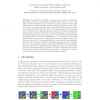Free Online Productivity Tools
i2Speak
i2Symbol
i2OCR
iTex2Img
iWeb2Print
iWeb2Shot
i2Type
iPdf2Split
iPdf2Merge
i2Bopomofo
i2Arabic
i2Style
i2Image
i2PDF
iLatex2Rtf
Sci2ools
FUN
2010
Springer
2010
Springer
The Complexity of Flood Filling Games
We study the complexity of the popular one player combinatorial game known as Flood-It. In this game the player is given an n×n board of tiles where each tile is allocated one of c colours. The goal is to make the colours of all tiles equal via the shortest possible sequence of flooding operations. In the standard version, a flooding operation consists of the player choosing a colour k, which then changes the colour of all the tiles in the monochromatic region connected to the top left tile to k. After this operation has been performed, neighbouring regions which are already of the chosen colour k will then also become connected, thereby extending the monochromatic region of the board. We show that finding an optimal solution for Flood-It is NP-hard for c 3 and that this even holds when the player can perform flooding operations from any position on the board. Next we show how a (c−1) approximation and a randomised 2c/3 approximation algorithm can be derived, and that no polynom...
Algorithms | FUN 2010 | Monochromatic Region | Player Combinatorial Game | Shortest Possible Sequence |
| Added | 19 Jul 2010 |
| Updated | 19 Jul 2010 |
| Type | Conference |
| Year | 2010 |
| Where | FUN |
| Authors | David Arthur, Raphaël Clifford, Markus Jalsenius, Ashley Montanaro, Benjamin Sach |
Comments (0)

